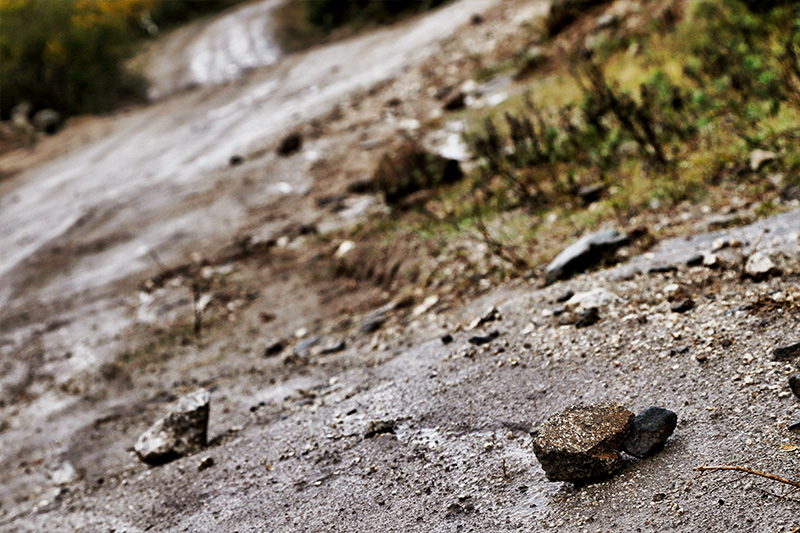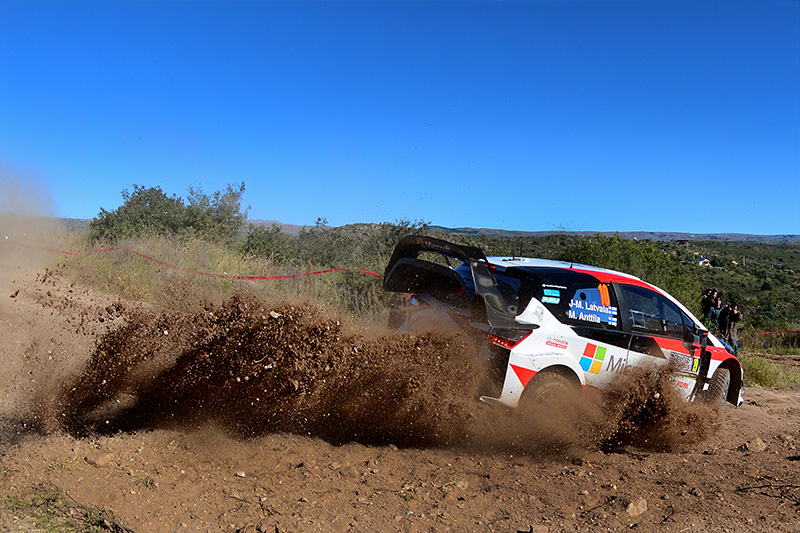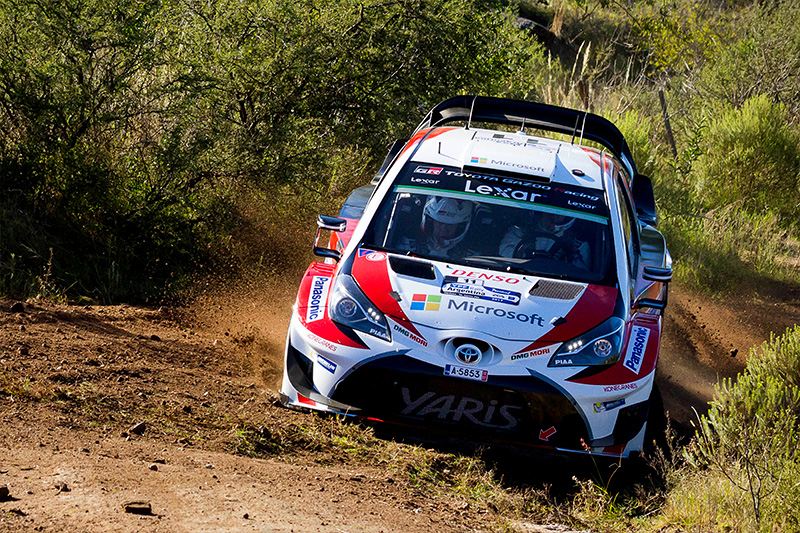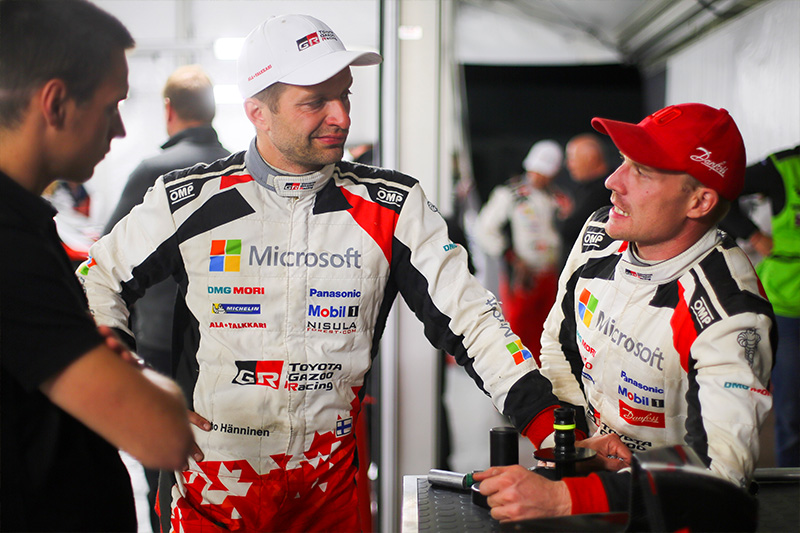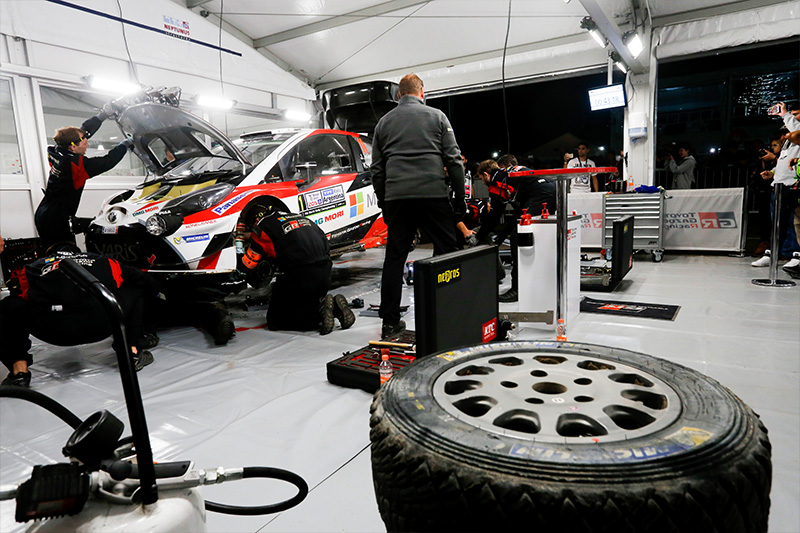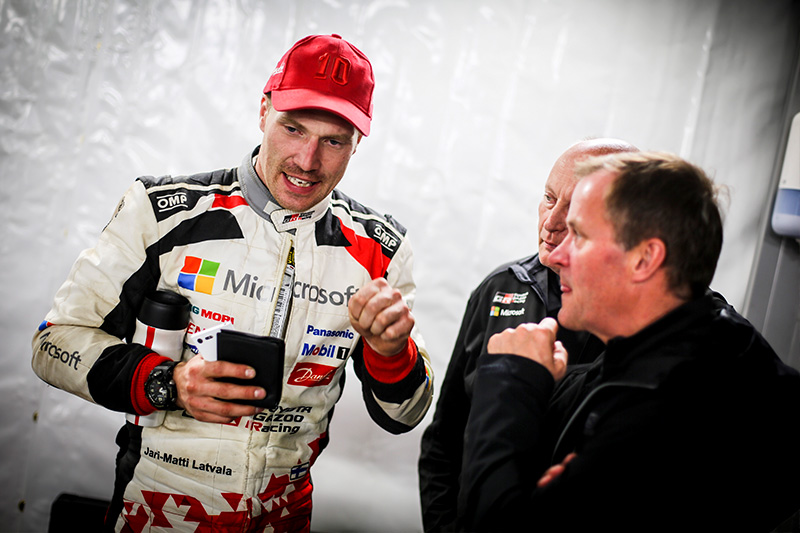Rally Argentina
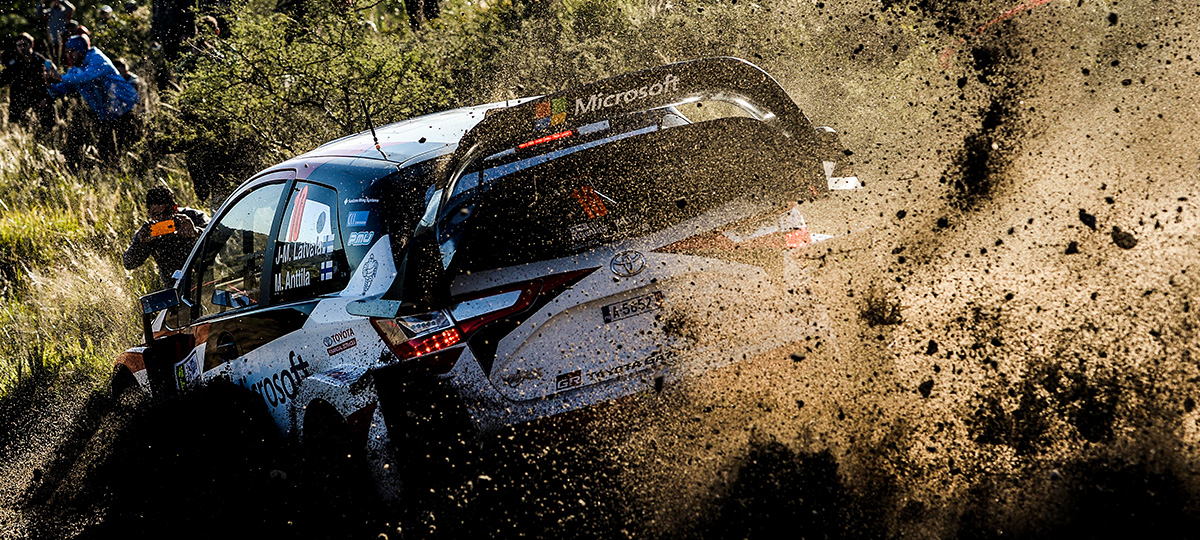
Discovering new issues on Argentina’s unimaginably rough gravel roads, and taking confidence from having both cars complete the rally
Autumn had just begun in the outskirts of Cordoba, Argentina, and there was a single spell of torrential rain in the week leading up to the rally. After the Thursday shakedown, however, the skies were clear and blue, and an abundance of sunshine made it feel like summer. Rally fans crowded the service park at Villa Carlos Paz, a lakeside resort neighboring Cordoba, bringing the lively and passionate atmosphere that is often associated with South American countries. Of all WRC events, it is at the Rally Argentina that the fans’ enthusiasm can be most powerfully felt.
Rally Argentina is run on gravel roads, but the quality of these roads varies greatly from area to area. On some courses, the roads are flat and wide, with a succession of gentle, high-speed curves; other courses are more technical, and packed with narrow, winding corners. There are also river crossings, jumps and all the other elements typical of WRC gravel rallies. For this reason, Rally Argentina is a favorite rally for many WRC drivers.
The unpaved roads of Rally Argentina are even rougher than usual—and they prove inhospitable as soon as the event begins
The course used for this year’s Rally Argentina was slightly different to previous years. After the recce, all the drivers were of the same, bewildered opinion: “The roads on this year’s stages are, on the whole, extremely severe. They are very uneven, bedrock is showing through the surfaces of the roads, and sharp stones are scattered everywhere. It will be almost impossible to avoid all the stones.” Perhaps they knew what to expect—that this year’s edition of Rally Argentina would become a cruel competition for survival.
Day two of the rally took place on the south side of Villa Carlos Paz, and the dilapidated Argentinian roads proved inhospitable almost from the outset. The majority of rally cars that returned to the service park after the morning’s stages were covered in battle scars: impacts from where they had hit the surfaces of the roads, and aerodynamic parts in pitiful condition after the striking the roadside banks. Only a handful of vehicles had emerged unscathed. Indeed, it was a blessing to even be able to return to the service park—after losing control on the rough terrain and overturning, some cars were forced to withdraw from the rally.
The two Toyota Yaris WRCs also had a baptism of sorts on the crude roads, losing the lower ends of their front bumpers, but the cars suffered comparatively little damage overall. Juho Hänninen’s car, however, was afflicted with an engine issue that caused a reduction in power. Team engineers investigated the problem during the daytime service park and discovered that some parts were no longer functioning properly after incurring strong impacts from the roads. The team was able to resolve the problem almost immediately, but Hänninen lost a substantial amount of time. Jari-Matti Latvala, meanwhile, was enjoying a superb start, lying second overall after the morning’s session. However, the temperature of his engine started to increase during the afternoon’s stages. Then, after overrunning a corner and striking the roadside bank with his Yaris WRC, one of his tires came off its wheel rim, and he ended up driving the last 15 km to the finish with only three functioning wheels. Latvala conceded a significant amount of time as a result and, unfortunately, his chances of victory were dashed even at this early stage.
While encountering new problems on the harsh roads, the team confirms the vehicle’s core strength
The problem of increasing engine temperature had also occurred at the previous gravel event, Rally México, but the team managed to identify the cause and implemented countermeasures as soon as the rally ended. Before Rally Argentina, the team conducted a pre-event test in Sardinia, Italy, and confirmed that the countermeasures were effective. However, the rising engine temperature in Argentina had an altogether different cause. Although both Mexico and Sardinia are gravel courses, the rough roads of Rally Argentina presented the team’s engineers with new challenges. Even though the engineers carried out thorough preparations and implemented ample countermeasures, the Argentinian roads proved extremely difficult; the engineers were forced to experience, once again, the severity and complexity of WRC courses.
While the engine presented the team with new areas for improvement, the team took great confidence in the durability of the vehicle body. Racing along extended stretches of extremely uneven road, the crews of both Yaris WRCs frequently hit the undersides of their cars against the hard road surfaces. Yet, the stout chassis of the Yaris WRCs endured these shocks resolutely, suffering no significant damage throughout the event. Of course, this was in no small part due to the exceptional vehicle control of the drivers; yet, even on the roads of Rally Argentina, which is no doubt one of the roughest rallies on the calendar, it was a great boon for the team to be able to confirm the durability of the Yaris WRC. In addition, while there were issues with the cooling system and other auxiliary functions, the engine itself was able to withstand strong external impacts and the increase in temperature, and continued to demonstrate outstanding performance to the very end of the rally.
Facing up to and overcoming unforeseeable problems leads to the accumulation of great experience and lots of data
Team Principal Tommi Mäkinen was adamant that this season, the first of Toyota’s return to WRC, was a year for learning. He commented: “Competing in rallies and facing unexpected problems is a tremendous asset for us, since our primary focus is learning. By overcoming each problem, we can acquire great experience and large amounts of data, and we can use this in the next rally. In this way, this team will grow stronger little by little.”
The next round of the WRC is Rally de Portugal, the season’s third gravel event. If the conditions are dry, the unpaved roads in the north of Portugal are expected to place great stress on the vehicles’ tires, with a high risk of punctures and abrasion. Portugal’s roads will no doubt pose an altogether different challenge to the TOYOTA GAZOO Racing World Rally Team compared to Mexico and Argentina. After returning to their European base, the team will use what they have learnt in Argentina and immediately work on improving the Yaris WRC to make it an even more powerful rally car.
RESULT
| Pos | Driver | Co-Driver | Vehicle | Time |
|---|---|---|---|---|
| 1 | Thierry Neuville | Nicolas Gilsoul | Hyundai i20 Coupe WRC | 3h38m10.6s |
| 2 | Elfyn Evans | Daniel Barritt | Ford Fiesta WRC | +0.7s |
| 3 | Ott Tanak | Martin Jarveoja | Ford Fiesta WRC | +29.9s |
| 4 | Sebastien Ogier | Julien Ingrassia | Ford Fiesta WRC | +1m24.7s |
| 5 | Jari-Matti Latvala | Miikka Anttila | Toyota Yaris WRC | +1m48.1s |
| 6 | Hayden Paddon | John Kennard | Hyundai i20 Coupe WRC | +7m42.7s |
| 7 | Juho Hänninen | Kaj Lindström | Toyota Yaris WRC | +11m16.9s |
| 8 | Dani Sordo | Marc Marti | Hyundai i20 Coupe WRC | +14m44.1s |
| 9 | Mads Ostberg | Ola Floene | Ford Fiesta WRC | +15m11.3s |
| 10 | Pontus Tidemand | Jonas Andersson | Skoda Fabia R5 | +17m32.1s |
